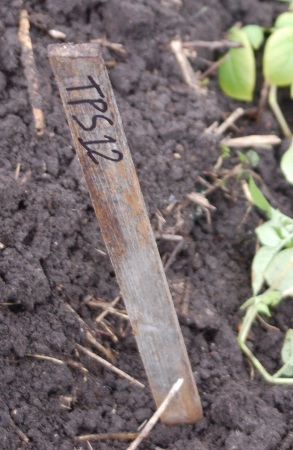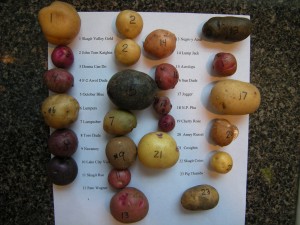 With the recent announcement by the British government to move forward with GM blight resistant potato trials, it’s time to say some more about the blight resistant potato trials being organized by US potato breeder Tom Wagner. I think there are important similarities and differences between these trials, and I’d like to explain some of them. I’ll certainly be talking about more of these things in later posts too.
With the recent announcement by the British government to move forward with GM blight resistant potato trials, it’s time to say some more about the blight resistant potato trials being organized by US potato breeder Tom Wagner. I think there are important similarities and differences between these trials, and I’d like to explain some of them. I’ll certainly be talking about more of these things in later posts too.

It was a rainy day yesterday as I planted out my seedlings grown from True Potato Seed (TPS) received from Tom, so the pictures probably seem a little grey. Rebsie of Daughter of the Soil planted hers out a few days ago, and many others across Europe are planting them in their gardens too. This past year Tom travelled across Europe, meeting people, giving away his seeds and doing a series of workshops.
These seedlings are results of crosses made by Tom in his garden, between different historical and modern potato varieties. There are a lot of these crosses, and for the sake of convenience these new varieties don’t yet have names but rather have been assigned a number.

These numbers and the genetics behind them are discussed by Tom in the videos I linked to above.

I was a little late in planting these seedlings out, and you can see some of the new tubers are starting to form in the little plastic pots I started the plants in. Sorry, my camera didn’t focus properly on this.
In Simple Terms — The Genetics
The UK scientists say they are trialling two genes found in wild potato relatives, shown to result in late blight resistance. These genes have been inserted into Desiree, a common commercial potato variety. I have yet to verify this, but I believe we have these same two genes in our potatoes. In this sense, our trials overlap. [edit: This probably isn’t true]
The genes in Tom Wagner’s potatoes go far beyond the trial in the UK.
Before, during and after Tom’s trip to Europe he’s been searching for and collecting the genetic materials from varieties of potatoes already shown to have blight resistance. He’s been doing this by collecting tubers and seeds from these plants, putting them in has garden in the US, and using traditional breeding methods to cross pollinate them. As opposed to the two genes the UK scientists are working with, Tom is working with millions of genes.
One Gene is Not Enough
One of the problems in breeding late blight resistance in potatoes is it’s a quickly mutating disease, capable of overcoming the resistance in a short time. Many varieties created in the past are no longer resistant for this reason. In order to overcome this problem, and create a variety that’s even more resistant, it’s necessary to use combinations of genes. This is why the scientists in the UK are working with two and Tom is working with as many as he can find.
This is often referred to as vertical resistance or gene stacking.
The Ongoing Battle
Late blight dates back to the time of the Irish Potato famine when the potato varieties grown were susceptible to the disease and all quickly destroyed by a sudden outbreak. The problem was made worse, because the number of varieties grown was very small, so there was little chance of any of them having natural resistance.
It’s believed late blight was originally brought to Europe in an infected tuber in a potato shipment from North America. The disease quickly spread in Europe because the climate here provides a much more favorable environment for it. It was also an unusually serious problem because the potato had become one of the most important sources of food for Europeans.
The approach taken to control late blight until now has been with chemical fungicides. This approach has not been without it’s problems however.
Late blight is nearly impossible to control once the plant has become infected. There are chemicals that can do this, but are generally considered too toxic for human consumption. This means you have to prevent the plants from becoming infected in the first place, and so you need to begin applying chemicals when you first think an infection may be possible, often weeks before an infection would actually occur.
As late blight has mutated over the years, the chemicals used to control it have necessarily become stronger and stronger and more toxic to both people and the environment. We are now to the point where literally tons and tons of these chemicals are used every year in Europe alone. It’s to the point where developing stronger chemicals is no longer feasible.
A recent development in late blight mutation is it’s now reproducing sexually, and different strains can now exchange DNA. Until now all reproduction has been asexual, meaning mutations were considerably slower. It’s all but assured future mutations of late blight will now occur much more rapidly.
Two-Gene vs. Multi-Gene Approach
The two gene approach taken by the UK scientists has a high chance of resulting in late blight resistance. The real question however, is how long this resistance will last.
The argument of course, is when the resistance of this variety is no longer adequate, they will look for more genes in wild potato relatives and create a new GM variety. If necessary, they can use more than two genes. This approach however looks an awful lot like the fungicides now being used. As these scientists move from one gene to the next, work their way through all the combinations they think of, eventually they will reach the end when it no longer works.
In a case like this, the interactions between all the genes are not likely to ever be fully understood. The UK scientists will only be working with genes or combinations of genes they can single out as being important in existing varieties, and they won’t see everything.
Tom’s multi gene approach on the other hand is much more likely to be sustainable, and is more likely to show functional resistance on farms.
By using Tom’s approach an unknown number of genes will be involved in the resistance. By taking existing resistant varieties, using the combinations of their genes in their entirety, all genes involved in that resistance can be used, not just the ones that can be specifically identified. In addition, by creating crosses with several different resistant varieties, all the genes from all the varieties can be used in their totality and in different combinations.
By creating a number of resistant varieties in this way, then growing them in different places and continuing the process of crossing new resistant varieties as they appear, new resistant genes will be discovered. This is in part because there will be natural mutations in the plants themselves creating new genes, but also previously unknown ones will be found. This ongoing process is much more likely to produce late blight resistance in the long run, and the chance of ‘running out of genes’ like what will happen eventually with the GM approach is significantly reduced.
In addition by working with a number of different varieties resistant to late blight in different ways, all at the same time, the chance of losing the entire season’s potato harvest like what happened during the Irish Potato Famine is significantly reduced.
Other Benefits of Biodiversity
There is another very important benefit to Tom’s multi gene approach. If one picture is worth 1000 words, have a look at some of Tom’s recent potato lines (click to enlarge):

Which would you rather eat, one of these or a GM Desiree potato?
One of the things Tom likes doing is working with older varieties that were favorites among our ancestors. For example, Tom has Irish roots and likes to work with the Lumper potato which was the most widely grown at the time of the Irish Potato Famine. In fact he’s created a number of blight resistant varieties using the Lumper as a basis.
By using Tom’s traditional breeding methods, it’s possible to recover traits in popular old varieties, and bring them back into new ones.
Some Other Important Differences
How about we talk security fences here? Here’s a picture of my security fence:

It’s a 4 ft hedge behind a shallow canal.
Unlike the £20.000 8 ft security fence and 24 hour security guard the scientists in the UK have, I only have the good graces of the other allotmenteers in my complex. Someone is usually around in the day, but otherwise my plot is unattended.
Another difference is funding. The costs of everyone participating in Tom’s trials are paid out of pocket. Tom in particular has devoted his whole life to his work, has never been paid royalties for his varieties, and uses huge amounts of his family’s money to pay his costs. If we had the money invested in the UK security fence alone, we could dramatically expand our trials not to mention offset some of our expenses.
A Specific Response to the UK Scientists
In the media recently were some statements made by people involved in the UK trials, and I wanted to respond to one of them.
From the BBC:
Professor Jones said that the trial was well within the biosecurity parameters required in order for permission to be granted.
“The rules are that the field trial has to be at least 20 metres from adjacent conventional potato fields,” he said.
“Very hypothetically, if a few pollen grains make it from our GM potatoes to some cultivated potatoes, given that we do not eat the fruit but the tubers, there is absolutely no way that the DNA we use can enter the human food chain.”
“There are also no wild relatives of potato in Europe that it could cross (breed) with.”
I think the argument could be made that contamination from the field trial is unlikely, but the idea of 20 metres being adequate isolation is totally absurd. First the variety used in this trial, Desiree, produces large amounts of pollen and is a very poor choice in terms of reducing contamination. Insects can carry pollen from potatoes large distances, and if these potatoes are ever grown commercially the contamination would be widespread. If the scientists were concerned about spreading contamination, why not use a variety that doesn’t produce pollen?
A male sterile variety, for example British Queen, could easily pick up a single grain of pollen from this GM variety, turning it into a seed ball that could get lost in the field and produce weeds for years to come.
Potato tubers themselves are always left behind in farmers fields, which then turn into weeds. Potatoes by their nature are a weedy plant. There may not be potato relatives growing wild in Europe, but there are plenty of possibilities for contamination.
The spreading of this sort of contamination threatens the breeding work I’ve laid out here, and puts the entire future of organic potatoes in jeopardy.


 With the recent announcement by
With the recent announcement by 



